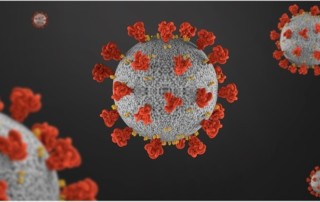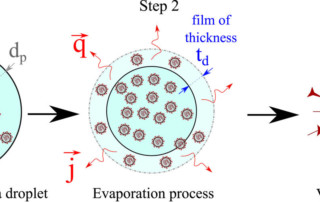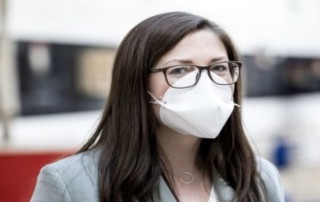COVID-19
UNIC Coronavirus Health and Research Portal
On Coughing and Airborne Droplet Transmission to Humans
Talib Dbouk and Dimitris Drikakis
University of Nicosia, Nicosia, Cyprus
The recent COVID-19 pandemic prompted the need for deeper understanding of the transport of fluids and droplets emanating from our respiratory tracts when we cough, sneeze, speak or breathe. The droplets transport will influence the spread of coronavirus and determine the implementation of guidelines about social distancing, mask wearing, crowded gatherings, as well as everyday practices of social behaviour in private, public and business environments.
The results of our research showed that in open spaces, airborne droplets carriers can travel significantly further than the 2 meters recommended distance due to the wind speed. The issues arising from the past and recent pandemic require a holistic approach to elucidate the open scientific questions and address the practical challenges. Such an approach would require closer interaction between bio-medicine, engineering fluid physics, and social sciences.
Figure 1
Saliva droplet cloud kinematics show the diameter of the droplets resulting from a human cough. Larger droplets settle more rapidly than smaller ones due to gravitational forces. The wind speed is approximately 0 km/h. The total mass of ejected saliva is 7.7 mg, with 1008 total number of droplets. The environment is at ambient temperature, pressure, and relative humidity of 20 oC, 1 atm, and 50%, respectively, with the ground temperature at 15 oC. The droplets in the figure have been scaled up for visualisation purposes.
Figure 2
A human cough: saliva droplet’s disease-carrier particles emanating from coughing do not travel more than 2 m in space at approximately zero wind speed. The environment was considered to be at ambient temperature, pressure, and relative humidity of 20 oC, 1 atm and 50% with the ground temperature at 15 oC.
Figure 3
Saliva droplets can travel large distances, depending on environmental conditions such as wind speed, temperature, pressure and humidity. Wind shown blowing left to right at speeds of 4 km/h (top) and 15 km/h (bottom) can transport saliva droplets up to 6 meters. The droplets in the figure have been scaled up for visualisation purposes.
What Does This Mean?
- In open spaces, airborne droplet carriers can travel significantly further than the 2m recommended distance depending on the wind speed and the environmental conditions. The above is an important finding and Citizens and policy-makers should be aware of it.
- If a person is in the path of the virus cloud, the risk of infection will, most likely, depend on the dosage and time of exposure. Therefore, it is crucial to better understand which scenarios may allow the transmission at longer distances. The present study contributes to advancing the above understanding.
- The dosage and time needed for an infection is still under study and may vary from one person to another. Further research and closer interaction between bio-medicine and engineering fluid physics are necessary to understand the conditions under which patients are being infected.
Non-Technical Summary
The recent COVID-19 pandemic prompted the need for deeper understanding of the transport of fluids and droplets emanating from our respiratory tracts when we cough, sneeze, speak or breathe. The droplets transport will influence the spread of coronavirus and determine the implementation of guidelines about social distancing, mask wearing, crowded gatherings, as well as everyday practices of social behaviour in private, public and business environments.
When sneezing or coughing, larger droplets are formed by saliva, and smaller droplets by mucous coating of the lungs and vocal cords. The smaller droplets are often invisible to the naked eye. Past research has shown that most respiratory droplets do not travel independently on their trajectories. Instead, droplets in a continuum of sizes are trapped and carried forward within a moist, warm, turbulent cloud of air. Although the mechanisms of virus transmission are still under debate, it is widely accepted that aerosol or respiratory droplet transmission is the critical factor for the rapid spread and continued circulation of viruses in humans.
We think that it is likely the dosage and time of exposure which determine whether or not infection will finally occur. Therefore, it is crucial to decide on the scenarios that will allow the transmission to longer distances. Our study aimed at advancing the understanding of the transfer of airborne particle carriers to humans through advanced coupling between droplets and fluid flow modeling and simulation.
The initial modeling configuration of the problem takes into account several parameters that can influence the simulation, including the wind speed in an open environment.
An accurate prediction of the transfer of airborne particle carriers to humans from a cough is governed by the following modeling considerations that must be taken into account:
- The saliva droplets initial size distribution at the onset of the coughing event.
- The human mouth-print of the cough.
- The period of the cough and its intensity (or initial saliva droplets speed).
- The numerical modeling approach to capture the complex varying space and time scales, e.g. both heat and mass transfer considerations, modeling of mass and phase changes due to droplets evaporation, coalescence, break up and turbulent dispersion in interaction with the bulk flow field.
The computational domain in the simulation is a grid in front of the coughing person . The analysis involved running partial differential equations on 1008 saliva droplets and solving approximately 3.7 million equations in total.
Our findings showed that, when a person coughs, the wind speed in an open space environment significantly influences the distance that airborne disease-carrier droplets travel.
- Without surrounding wind speed, the droplets will fall to the ground in a short distance from the person exhaling or coughing. The present analysis shows that the range may not exceed one meter (See Figure 2). A tiny number of particles may travel slightly further longer. Still, their trajectory beyond one meter will already be at a height significantly below half a meter dropping towards the ground. Thus, these droplets may not constitute a risk regarding facial contact of adults at this distance.
- At wind speeds from 4 to 15 km/h, we found that saliva droplets can travel to distances up to 6 meters with decreasing concentrations and liquid droplets size in the wind direction (see Figure 2). Our findings imply that depending on the environmental conditions, the 2 meters social distance may not suffice. Further research is required to quantify the influence of other parameters such as the environment relative humidity and temperature amongst others.
- The droplets cloud will affect both adults and children of different heights. Shorter adults and children could be at higher risk if they are located within the trajectory of falling droplets.
- At a lower wind speed, the droplet total mass reduction occurs more slowly compared to a higher speed, which may prolong the exposure of a human to the droplets if the subject is located within the droplets envelope.
Overall, the results showed that in open spaces, airborne droplets carriers can travel significantly further than the 2 meters recommended distance due to the wind speed. The issues arising from the past and recent pandemic require a holistic approach to elucidate the open scientific questions and address the practical challenges. Such an approach would require closer interaction between bio-medicine, engineering fluid physics, and social sciences.
Figure 1
Saliva droplet cloud kinematics show the diameter of the droplets resulting from a human cough. Larger droplets settle more rapidly than smaller ones due to gravitational forces. The wind speed is approximately 0 km/h. The total mass of ejected saliva is 7.7 mg, with 1008 total number of droplets. The environment is at ambient temperature, pressure, and relative humidity of 20 oC, 1 atm, and 50%, respectively, with the ground temperature at 15 oC. The droplets in the figure have been scaled up for visualisation purposes.
Figure 2
A human cough: saliva droplet’s disease-carrier particles emanating from coughing do not travel more than 2 m in space at approximately zero wind speed. The environment was considered to be at ambient temperature, pressure, and relative humidity of 20 oC, 1 atm and 50% with the ground temperature at 15 oC.
Figure 3
Saliva droplets can travel large distances, depending on environmental conditions such as wind speed, temperature, pressure and humidity. Wind shown blowing left to right at speeds of 4 km/h (top) and 15 km/h (bottom) can transport saliva droplets up to 6 meters. The droplets in the figure have been scaled up for visualisation purposes.
The University of Nicosia (UNIC)
About the University of Nicosia
The University of Nicosia (UNIC) is the largest university in Cyprus, and the largest university in southern Europe that teaches primarily in English, welcoming 12,000+ students from over 70 countries worldwide. The University of Nicosia is a comprehensive university with 6 schools, 20 departments and over 100 degree programs offered on-campus and online.
The University of Nicosia is best known in the fields of medicine, law, blockchain, accounting, education, forecasting and international relations and for a series of partnerships with other leading European universities. UNIC was most recently ranked #106 in its region by QS and #300 to #400 globally in the Times Higher Education Impact rankings.
To learn more about the University of Nicosia, please see: https://www.unic.ac.cy/
UNIC’s COVID-19 Response
University of Nicosia faculty across a variety of academic disciplines are actively engaged in research and analysis and serving in scientific / public policy roles supporting the global COVID-19 response.
For more information about the University of Nicosia’s work relating to COVID-19 including potential collaboration, please see: https://www.unic.ac.cy/coronavirus/
Contact Information
For more information about this study, please contact Prof Dimitris Drikakis at [email protected].
For more information on our COVID-19 related research in general, please contact UNIC at [email protected].
Press Coverage
Articles and press mentions in global media about the research.
Evaporation critical to coronavirus transmission as weather changes – BIOENGINEER.ORG
Evaporation critical to coronavirus transmission as weather changes – BIOENGINEER.ORG WASHINGTON, September 22, 2020 — As COVID-19 cases continue to rise worldwide, it is increasingly urgent to understand how climate impacts the continued spread of the coronavirus, particularly as winter virus infections are more common and countries in the northern hemisphere will soon see cooler temperatures. In a paper in Physics of Fluids, by AIP Publishing, researchers studied the effects of relative humidity, environmental temperature, and wind speed on the [...]
Evaporation is critical for coronavirus transmission in winter
Evaporation is critical for coronavirus transmission in winter Interview conducted by Emily Henderson, B.Sc.Sep 28 2020 Dr. Talib Dbouk and Professor Dimitris Drikakis speak to News-Medical about their research efforts during the COVID-19 pandemic, and how evaporation is essential for coronavirus transmission in the winter. What provoked your research into the transmission of viruses, and in particular, that of the coronavirus? As researchers, our mission is to investigate and better understand the flow physics and transmission dynamics of viruses. What [...]
Evaporation is critical for coronavirus transmission in winter
Interview conducted by Emily Henderson, B.Sc.Sep 28 2020 University of Nicosia Dr. Talib Dbouk and Professor Dimitris Drikakis speak to News-Medical about their research efforts during the COVID-19 pandemic, and how evaporation is essential for coronavirus transmission in the winter. What provoked your research into the transmission of viruses, and in particular, that of the coronavirus? As researchers, our mission is to investigate and better understand the flow physics and transmission dynamics of viruses. What mainly provoked our research [...]
Weather impact on airborne coronavirus survival: Physics of Fluids: Vol 32, No 9
The contribution of this paper toward understanding of airborne coronavirus survival is twofold: We develop new theoretical correlations for the unsteady evaporation of coronavirus (CoV) contaminated saliva droplets
Ask Ethan: What Is The Science Behind Wearing A Mask?
Ask Ethan: What Is The Science Behind Wearing A Mask? It's not very often that a physics problem becomes a politicized issue, but that's exactly what's happened when it comes to the science of wearing a mask during the current coronavirus pandemic. Viruses are tiny particles; if you're infected, they exist within your body. Every time you breathe out, speak, sing, sneeze, cough, or otherwise exhale, some of those particles can escape along with the droplets that leave your body. [...]
Keep your distance; new study on coughing shows masks help, not perfect
Keep your distance; new study on coughing shows masks help, not perfect Several Port Aransas business owners are happy about the facemask order that will become law on Wednesday. As the debate about mask mandates continues in some states, a new study reportedly shows social distancing is just as important to reduce the spread of COVID-19. The study looked at the effectiveness of face coverings when someone coughs repeatedly, coughing is one of the symptoms of COVID-19. The study was [...]
Keep your distance; new study on coughing shows masks help, not perfect
Keep your distance; new study on coughing shows masks help, not perfect Several Port Aransas business owners are happy about the facemask order that will become law on Wednesday. As the debate about mask mandates continues in some states, a new study reportedly shows social distancing is just as important to reduce the spread of COVID-19. The study looked at the effectiveness of face coverings when someone coughs repeatedly, coughing is one of the symptoms of COVID-19. The study was [...]
Keep your distance; new study on coughing shows masks help, not perfect
Keep your distance; new study on coughing shows masks help, not perfect Several Port Aransas business owners are happy about the facemask order that will become law on Wednesday. As the debate about mask mandates continues in some states, a new study reportedly shows social distancing is just as important to reduce the spread of COVID-19. The study looked at the effectiveness of face coverings when someone coughs repeatedly, coughing is one of the symptoms of COVID-19. The study was [...]
Keep your distance; new study on coughing shows masks help, not perfect
Keep your distance; new study on coughing shows masks help, not perfect Several Port Aransas business owners are happy about the facemask order that will become law on Wednesday. As the debate about mask mandates continues in some states, a new study reportedly shows social distancing is just as important to reduce the spread of COVID-19. The study looked at the effectiveness of face coverings when someone coughs repeatedly, coughing is one of the symptoms of COVID-19. The study was [...]
Coronavirus, bei Wind ist der sichere Abstand von zwei Metern nicht genug
Coronavirus, bei Wind ist der sichere Abstand von zwei Metern nicht genug In den letzten Wochen wurden Modelle, Simulationen und Experimente eingeführt, um zu verstehen, wie das neuartige Coronavirus übertragen wird. Heute wissen wir, dass wir, wenn wir sprechen, niesen, husten oder sogar atmen, Tröpfchen unterschiedlicher Größe emittieren. Wenn wir krank sind, können diese infizierten Tröpfchen die Ursache für eine Ansteckung werden, die die Gesichter anderer Menschen oder Oberflächen erreichen, die infiziert werden würden. Um die Möglichkeit einer Infektion so [...]









